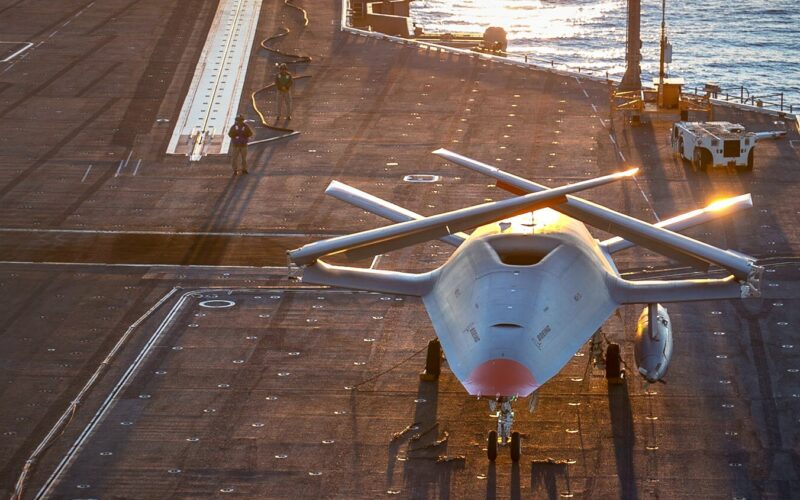Aviation
U.S. Navy Unveils First-Ever Drone Operations Hub on Aircraft Carrier

The U.S. Navy has taken a significant leap forward in naval aviation with the installation of the world’s first Unmanned Air Warfare Center (UAWC) aboard the USS George H.W. Bush (CVN 77).
This cutting-edge control center marks a new era in carrier operations, where Air Vehicle Pilots (AVPs) will oversee future MQ-25™ Stingray unmanned aerial operations, heralding the integration of drone technology into naval missions.
This ambitious project was a collaboration between several key naval entities, including the Naval Air Warfare Center Aircraft Division Webster Outlying Field Alteration Installation Team, AirWorks, and industry partner Lockheed Martin. Together, they ensured the seamless integration of this groundbreaking system.
At the heart of the UAWC is the Unmanned Carrier Aviation Mission Control System (UMCS) MD-5E Ground Control Station (GCS), the first fully operational and integrated system of its kind. This advanced control room, equipped with cutting-edge software and hardware, is the command hub for the MQ-25 Stingray, the Navy’s first unmanned aerial refueler.
Central to the GCS’s functionality is Lockheed Martin’s Skunk Works® Multi Domain Combat System (MDCX™), a sophisticated platform that powers the control station. This system, along with additional supporting equipment and hardware, forms the baseline for the production systems that will be installed on other carriers, including CVNs 70, 71, and 76, starting in fiscal year 2025.
The physical installation of the UAWC was a complex task, requiring precise coordination and execution. The Naval Sea Systems Command, Norfolk Naval Shipyard, and CVN 77 were instrumental in organizing schedules, equipment, and logistics, ensuring that the installation was completed efficiently and effectively.
Looking ahead, the USS George H.W. Bush is set to lead the first at-sea testing of the UAWC’s operational networks early next year. This testing phase will build on the initial network testing conducted in January aboard the USS Abraham Lincoln (CVN 72), where a simulated GCS was used to validate the system’s capabilities.
The successful integration of the MQ-25 into carrier operations is overseen by PMA-268, the lead systems integrator, which works closely with industry giants Boeing and Lockheed Martin.

Aviation
Airbus Enhances A350 Cabin with 10-Abreast Seating

Airbus has announced a new partnership with Jiatai Aircraft Equipment, a Chinese aircraft seating manufacturer, to supply upgraded economy-class seats for the A350 widebody series.
This collaboration, unveiled at the 2024 Airshow China, focuses on developing a newly designed economy seat tailored for the A350‘s New Production Standard (NPS) cabin.
One of the key features of the NPS cabin is the ability to accommodate 17-inch wide economy seats, compared to the previous 16.5-inch wide seats that airlines were limited to in the A350’s earlier configurations.
British Airways Unveils Its Brand-New First Class Cabin for the Airbus A380
This change is made possible by the expanded space in the NPS cabin, which is 35 inches longer and 4 inches wider than the previous version. This extra space is achieved by slightly moving the cockpit wall forward and shifting the rear pressure bulkhead back by one frame.
The wider cabin allows airlines to add up to 30 extra economy seats without compromising comfort. For airlines opting for a 3-4-3 seating layout, the 17-inch wide seats are an excellent choice for a more comfortable passenger experience. However, some airlines, such as Iberia, may choose to retain a 9-abreast layout with wider seats for added comfort.
The NPS cabin also offers enhanced flexibility for airline operators. One major advantage is the ability to easily switch between a 9-abreast and 10-abreast seating configuration without requiring significant downtime for aircraft reconfiguration. Airlines can use the same seat rails, tracks, and IFE interfaces, making the transition smoother and quicker.
Etihad Airways Unveils 10 Exciting New Routes for 2025
In addition, the design of the floor attachments and air-conditioning systems has been optimized for 10-abreast seating, meaning airlines can upgrade their cabins without needing to make substantial modifications to the aircraft’s structure.
Though it’s still unclear when Jiatai’s economy-class seats will be officially added to the A350’s Buyer Furnished Equipment (BFE) catalogue, the collaboration marks a significant step toward enhancing the A350’s cabin offerings.
With this partnership, Airbus is providing more seating options for airlines, ensuring that they can meet diverse customer needs while improving overall operational efficiency.
-

 Aviation2 months ago
Aviation2 months agoMicrosoft Flight Simulator Raises $3 Million to Bring Back the An-225 Mriya
-

 Airlines2 months ago
Airlines2 months agoQatar Citizens Can Travel to the United States Without a Visa
-

 Aviation2 months ago
Aviation2 months agoQatar Airways bans these new Electronic Devices on plane
-

 Airlines2 months ago
Airlines2 months agoJapan Airlines Rolls Out Free Domestic Flights to International Passengers
-

 Defence2 months ago
Defence2 months agoWhich Country Has the Largest Fleet of Fighter Aircraft?
-

 Airport2 months ago
Airport2 months agoWestern Sydney Airport Welcomes Its First Plane After 6 Years of construction
-

 Airlines4 days ago
Airlines4 days agoDAMAC Air: Dubai’s New Luxury Airline Offers Free Flights for Registration
-

 Aviation2 months ago
Aviation2 months agoDid you know ? Once Boeing 747 carried 1088 passenger in 1991








